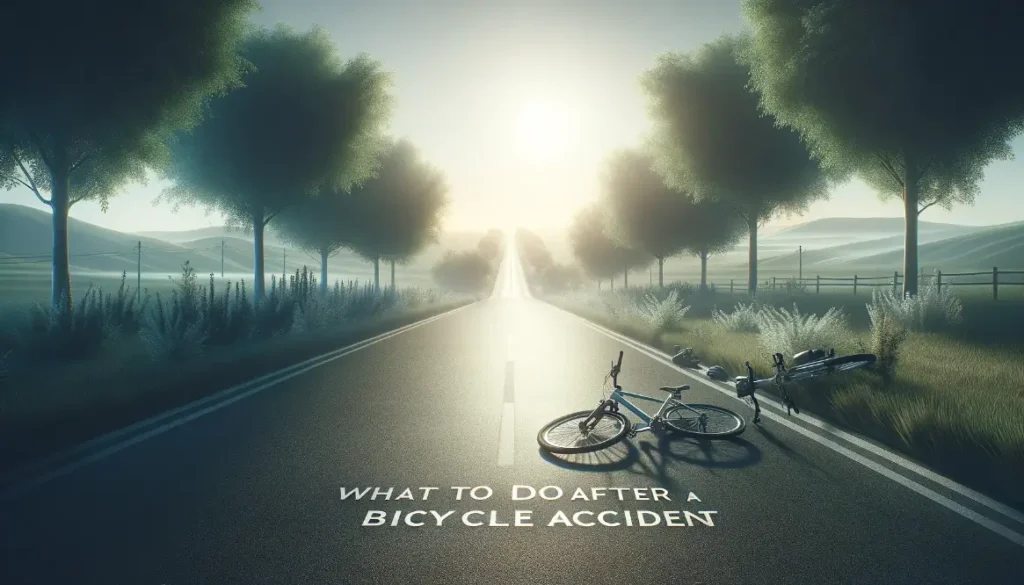
Suffering a bicycle accident can be a traumatic and overwhelming experience. With adrenaline pumping after an unexpected crash, you may be unsure where to start when it comes to dealing with the aftermath. This step-by-step guide outlines important actions to take after a bike accident, including seeking medical treatment, collecting evidence from the scene, informing key parties, addressing physical and emotional impacts, and ultimately learning from the incident.
Assess Your Condition
The first priority after any accident is always to check yourself for injuries and determine if emergency services are required. Move to a safe area if you are still near traffic, then conduct a mental scan of your body, feeling carefully for pain or abnormalities. Also examine yourself visually to spot any bleeding, bruising, swelling, or other signs of harm. Common bicycle crash injuries include:
- Scrapes and cuts
- Sprains and fractures
- Traumatic head injuries like a concussion
- Internal bleeding and organ damage
If you are unable to move or transport yourself for care, have symptoms like difficulty breathing, seizure, loss of consciousness, or significant bleeding, call 911 immediately. Stay still while waiting for emergency services to arrive.
Only continue home or operate your bike again once you confirm you can safely do so. Many crash-related injuries like fractures or internal trauma can be serious yet not cause immediate symptoms. Seek emergency care even hours later if issues arise. Monitor yourself closely over the next 48 hours for delayed onset of problems. Consult a doctor if you have any concerns about injuries possibly needing treatment.
Seek Medical Attention
Getting properly examined and cared for by a medical professional should happen promptly after any significant cycling incident. This establishes what injuries you have and prevents small issues from developing into more serious, lasting health problems over time.

For non-critical issues, your family doctor or an urgent care walk-in clinic can provide evaluation and treatment, including stitches for cuts, crutches, or referrals for specialized care. Head to the emergency room at your local hospital if you have symptoms like:
- Severe or worsening pain
- Inability to fully use a body part
- Persistent dizziness, nausea, mental confusion
- Known or suspected head, spinal cord, internal or orthopedic injuries
- Signs of shock like rapid breathing, weakness, clammy skin
Be prepared to provide the physician with details about your accident and symptoms. Follow all directives for medical tests, procedures, medication, equipment rentals, rehabilitation exercises, and further follow-ups closely to support your recovery. Keep documentation of your visit and care instructions as evidence for potential insurance claims or lawsuits.
Document the Accident
While still at the accident scene if possible, gather information and proof of circumstances that led to your crash. This facilitates handling logistics like repairs, insurance claims, and legal action later on. Key documentation to obtain includes:

- Photos: Capture images showing bike damage, road conditions, visibility, signage issues, debris hazards, potholes, weather or anything else potentially contributing to the incident. Also photograph any injuries while fresh.
- Party contact details: For collisions involving motor vehicles or pedestrians, record license plate numbers, driver’s insurance details including provider and policy number, plus full names and contact info of all individuals involved.
- Witness accounts: Get names and phone numbers of anyone who observed the incident, especially neutral bystanders. Their future testimony can affirm what transpired.
- Police report: Call law enforcement to officially log details for investigation and insurance purposes. Provide clear account of events when interviewed for documentation accuracy.
See also: What States Can You Get a DUI on a Bicycle?
If you don’t gather necessary reporting materials at the scene, follow up as soon as feasible after receiving medical care. Insurers need prompt notification and reports filed within hours to days of accidents to process related claims.
Report the Accident
In addition to informing police, contact key administrative parties to activate relevant processes like repairs, financial coverage and liability matters.
Inform your insurance provider: Call with notification at the earliest possible opportunity per individual policy guidelines. Be prepared to answer questions about what happened and describe bike damage, injuries incurred and possible losses needing reimbursement. Send any documentation gathered to support your account.
Notify your employer if the crash occurred during work activities: For bicycle couriers, food delivery cyclists and other riders occupied in job duties at the time, employers carry responsibility for registered workplace incidents. Reporting activates their insurance benefits you may leverage for compensation.
Address Vehicle Damage
Assess the state of your bike post-crash before attempting to transport anywhere to identify needed repairs. Beyond bent components or dings, inspect for bigger structural issues like frame cracks that could make riding hazardous.
For bikes rendered unsafe or inoperable from an accident, arrange pick-up and transport options. Bike shops can dispatch vehicles for retrieval if you cannot convey it yourself. They can also provide estimates on costs to restore damaged parts or full replacements if a write-off.
Save damaged original components until insurance appraisal is complete whenever feasible. Take detailed images showing problems if unable to store mangled parts. Approvals for new equipment payouts rely on documenting beyond repair status.
Follow Up on Injuries

Ensure you schedule and complete all medical directives in the days, weeks and months following your accident fully as prescribed by treating physicians. These include but aren’t limited to:
- Diagnostic tests: Imaging exams like X-rays, CT scans or MRIs pinpoint hidden underlying issues requiring care after crashes. Bone fractures, organ damage and traumatic brain injuries often emerge this way after adrenaline wears off.
- Specialist referrals: You may need input treating concussions, fractures, sprains, and other complex post-crash problems from experts like sports medicine doctors, orthopedic surgeons or neurologists.
- Rehabilitation plans: These progress recovery of injured muscles, tissues and joints through stretches, strength training and other therapies. Guidance from physical and occupational therapists optimizes outcomes long-term.
Closely track symptoms and progress between appointments to relay back to doctors. Report setbacks or plateaus hindering your ability to heal. Ongoing problems may necessitate revised treatment plans, alternate therapies or additional medication.
File Insurance Claim
Work promptly with your insurance provider by submitting required documentation to activate financial coverage for accident-related costs. Timing affect what benefits apply and claims acceptance, so know policies thoroughly.
Collect needed documentation: Insurers require detailed evidence showing damages incurred. Organize things like police reports, medical invoices, property repair estimates from accredited mechanics, and records of missed wages due to injury recovery periods.
Submit Claim Paperwork: Formally request payouts for all applicable coverages by providing paperwork outlining what you want reimbursement for and supporting proofs. Common claims include property damage, loss of income, disability assistance, and compensation for pain/suffering.
Be prepared to answer questions from claims adjusters during review processes before receiving any settlement offers. Negotiate politely if amounts suggested seem inadequate for losses experienced. Reach out promptly for assistance if claims are denied outright so appeals support staff can advise next steps arguing your case further.
Handle Legal Matters
For accidents clearly caused by provable negligence of other parties like drivers, corporations or government entities, consult personal injury lawyers to pursue formal lawsuits awarding rightful compensation. They build strong legal cases demonstrating owed liability.
Lawyers also shield clients from bullying tactics used by opportunistic defense teams aiming to minimize settlement payouts, and guide injured plaintiffs through complicated justice processes getting lost alone can impede outcomes. Handling communications, submitting briefs, retaining expert testimony and showing up for you at court appearances all fall under counsel’s role.
If you receive notice about lawsuits filed against you alleging responsibility tied to the accident, immediately pass documents received to your insurance provider or retain counsel specializing in bicyclist liability defense arrangements can be made discreetly shielding you from publicity during proceedings. Again, responding accurately within specified timeframes preserves your rights so promptness matters.
Take Steps to Heal
Caring properly for your body and mindset facilitates complete recovery and getting back to regular life after a cycling crash. Key principles to remember include:
Get adequate rest: Listen to physicians’ advice about avoiding strenuous activities, plus general suggestions to take it easy and sleep more while recuperating even if you feel restless. The body and brain need recharging time to mend fully.
Eat nutritious foods: Stock up on ingredients to prepare balanced meals and stay hydrated. This nourishes the body properly to enable healing. Avoid junk foods that can prolong inflammation.
Treat pain and symptoms: Use RICE (Rest, Ice, Compression, Elevation) methodology plus take medications as directed by doctors to help manage issue like swelling or headaches impeding daily function.
Attend all follow-up appointments: See all specialists referred for ongoing care like scans to assess bone regeneration, concussion clinics to check cognitive function gains etc. Full duty releases by doctors come only after determining you meet fixed recovery milestones.
Avoid risky activities: During recovery periods, steer clear of behaviours potentially aggravating healing like drinking excess alcohol which slows bone fusion, contact sports that could re-injure damaged tissues before completely knitted etc. Follow all physician-provided precautions.
Practice relaxation techniques: Try yoga, deep breathing, meditation, massages and other stress reduction tactics if feeling anxious, frustrated or depressed by the challenges of recovering. Support mental health resilience along the way.
Address Mental Impact
Experiencing a disturbing accident can negatively impact mental health even after physical recovery is complete, especially if you felt severe fear for your safety during the incident. Seeking counseling helps prevent development of long-term issues like cycling phobias.
Consider counseling: If struggling with emotions like anxiety preventing you from normal activities like riding your bike again, make an appointment to see a psychologist experienced in treating trauma and phobias. They use tailored therapy approaches proven to help, like systematic desensitization.
Practice self-care: Don’t ignore emotional needs and tend carefully to your overall mental wellbeing using healthy coping strategies that comfort you. Ideas include journaling feelings, joining support groups to share experiences, or taking up mood-boosting hobbies.
Try stress management tactics: Yoga, mindfulness mediation, deep breathing exercises, spending time outdoors in green space and avoiding stimulants like caffeine can reduce feelings of anxiety aggravated by enduring a disturbing event.
Remain patient with yourself: Emotional recovery also takes time, so do not get discouraged by ups and downs. With consistent counselling support plus self-nurturing strategies, distressing feelings and accident fears start subsiding.
Improve Bike Safety
Before riding your bicycle again after injuries heal, take proactive measures decreasing chances similar harmful incidents reoccur.
Inspect and repair bike damage: Ensure any wrecked components like brakes get professionally serviced or replaced if compromising function. Perform safety checks like inspecting tire treads and ensuring proper inflation before hitting the road again.
Upgrade gear: Consider investing in protective equipment minimizing harm risks if future falls or collisions transpire regardless of skills improving. Ideas include helmets with enhanced safety ratings, back/limb armor, airbag vests, or more visible attire.
Enroll in skills courses: Take local cycling organization programs teaching savvy bike handling techniques along busy roads. Learn to navigate varied hazards confidently. Sharpen emergency maneuvering responses averting danger.
Review riding rules: Refresh understanding of regional regulations ensuring you operate lawfully in traffic scenarios. Obey all stop signs/lights, yield when required, signal turns properly and avoid illegal moves increasing likelihood of police ticketing.
Become an Advocate
If shortcomings around infrastructure design, policy enforcement or public awareness enabled the accident you endured, get motivated to catalyze changes preventing the same happening to fellow riders later on.
Raise safety awareness: Get involved with or donate to non-profits educating road users about safe practices around cyclists. Share accident experience details illustrating urgency for improvements regarding driver conduct, investment in dedicated lanes etc.
Support advocacy campaigns: Get vocal backing initiatives petitioning transportation departments for improved cycling networks segregating riders from heavy traffic, which research shows prevents collisions. Attend public consultations regarding infrastructure decisions to argue the case directly to policymakers.
Organize community events: Arrange public demonstrations bringing media attention to lack of cycling safety progress after incidents causing preventable harm continue happening. Unite supporters lobbying governing stakeholders for reform through strength of numbers.
Submit hazard reports: Officially document dangers like potholes causing crashes then advocate the right agencies accelerate repairs keeping the route usable without injury risk. Apply public pressure by sharing details online until deficiencies get addressed.
Decide If You Will Ride Again
It is normal to feel hesitant or fearful getting back onto a bicycle initially after an accident, even if all physical recovery milestones get cleared by doctors. Carefully weigh your personal factors deciding if/when returning to cycling is appropriate.
Consider risks vs rewards: Honestly assess whether the mobility convenience, exercise benefits and enjoyment aspects of riding offset potential to endure future crashes. Would switching transportation modes like public transit serve you better without safety concerns?
Start slowly: When ready to ride again, ease in gradually on quiet side streets acclimatizing. Avoid routes causing anxiety at first. Ask friends to join providing companionship and support building confidence handling busy roads independently once skills get re-established.
Accept it may take time: Be patient with yourself redeveloping courage and ability if cycling confidence got shaken after trauma endured. Consider counseling if struggling to overcome fear-based barriers hindering a return to bicycle commuting you otherwise value.
Learn from the Experience
Reflect constructively on the accident by identifying behavioural factors, knowledge gaps or other issues potentially within your control that played a role events unfolding as they did. Determine what you would do differently next time.
Consider lessons learned: Were you distracted by devices when navigating the area where you crashed? Disobeying any traffic rules subsequently creating liability? Rushing while fatigued or in adverse weather? Be honest about risky choices made so you change tendencies.
Identify knowledge gaps: Lack of understanding regional laws or handling techniques around common obstacles like streetcar tracks, road cracks etc? Seek education opportunities better preparing you for diverse conditions faced.
See also: Cycle Theft Complaint Letter: Safeguarding Your Bicycle from Theft
Evaluate safety gear used: Perhaps a helmet with MIPS technology would have reduced concussion severity? More durable tires may not have skidded across oily pavement? Assess efficacy of current equipment choices.
By applying insights gained about targeted training required, tactical errors to remedy or preparedness investments able to optimize future cycling safety outcomes, the difficult experience becomes an opportunity helping prevent history repeating going forward.
Frequently Asked Questions
What should I do at the scene of a bike accident?
Prioritize injury assessment and treatment, then gather documentation about what happened including taking photos capturing damage, obtaining witness statements, acquiring contact details from involved parties like drivers, and contacting police to file an official report you can supply insurers attributing fault/liability later.
Do I have to report a minor bike accident to the police?
While legally you may not need to report low-impact solo crashes causing only minor abrasions or bike damage, filing police documentation proves important for insurance claims, legal liability investigations, and motivation of responsible agencies addressing local hazards contributing to crashes then vs ignoring issues. Give an official account.
How long do I have to make an insurance claim after a cycling accident?
Deadlines to activate relevant coverages related to crashes vary widely by unique provider policies, but most necessitate at least initial accident notification within 7-28 days, with formal claim paperwork due soon after. Read your insurance documents thoroughly understanding case documentation factors that could risk declination if information gets submitted past arbitrarily defined cut-off periods.
Can I ride my bike again after an accident?
With clearance from all treating physicians after completing prescribed recovery treatment plans, plus fully mended vehicle damage assessed by mechanics specializing in bikes, individuals can technically resume cycling post-accident physically. But proceeding gingerly rebuilding confidence handling busy roads without fear may take patience, by starting on quiet side streets then progressing back to regular commuting routes. Seeking counseling assists if struggling emotionally.
What safety gear could have prevented my crash injuries?
Upgraded helmets with MIPS technology show proven ability reducing concussion severity if head impacts ground during crashes; more durable tires resist skidding across slick road hazards; high visibility clothing enhances rider conspicuousness to motorists; and armored shorts, spine protectors or airbag vests shield limbs/vital areas from trauma if falls or collisions transpire regardless of defensive skills applied. Investing in robust protective equipment strongly aids risk reduction.
Conclusion
Suffering any kind of accident while cycling can prove physically painful, mentally disturbing, inconvenient and costly. But by taking the right steps after crashes occur – seeking prompt medical care, collecting documentation, protecting your legal rights, attending prescribed recovery treatments, upgrading safety gear used, considering emotional impacts, and applying lessons learned to prevent repeat issues in future – negative effects can be minimized as much as possible. Arm yourself with this bike mishap response knowledge so no situation catches you off guard. Stay safe on the roads by controlling only factors within your power, while advocating fiercely to transform external deficiencies putting riders unjustly at risk. With preparation and resilience, the cycling community continues working towards the vision of this sustainable transportation option becoming safer for all participating in it.






